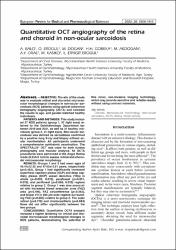Quantitative OCT angiography of the retina and choroid in non-ocular sarcoidosis

View/
Access
info:eu-repo/semantics/openAccessDate
2022Author
Balcı, AydınEroğul, Özgür
Doğan, Mustafa
Gobeka, Hamidu Hamisi
Akdoğan, Müberra
Oral, Ayşe Yeşim
Kaşıkçı, M
Eryiğit Eroğul, Leyla
Metadata
Show full item recordCitation
Balcı, A., Eroğul, O., Doğan, M., Gobeka, H. H., Akdoğan, M., Oral, A. Y., & Kaşıkçı, M. (2022). Quantitative OCT angiography of the retina and choroid in non-ocular sarcoidosis.Abstract
OBJECTIVE: The aim of the study was to evaluate retinal and choroidal microvascular morphological changes in non-ocular sarcoidosis (NOS) patients using optical coherence tomography angiography (OCTA) and compare the results to age- and gender-matched healthy individuals.
PATIENTS AND METHODS: This study included 37 NOS patients (group 1, 37 right eyes) referred to the Ophthalmology Department between 2019 and 2021, as well as 31 healthy individuals (group 2, 31 right eyes). Non-ocular sarcoidosis was defined as sarcoidosis confirmed by a positive lung X-ray and biopsy without ocular manifestation. All participants underwent a comprehensive ophthalmic examination. The SPECTRALIS® OCT was used for both fundus photography and macular analysis. All OCTA procedures were performed in the Angio Retina mode (6.0×6.0 mm) to assess retinal and choroidal microvascular morphology.
RESULTS: Groups 1 and 2 had mean ages of 46.41±12.52 and 47.55±13.81 years, respectively (p=0.482). Group 1 had significantly increased superficial capillary plexus (SCP) and deep capillary plexus (DCP) vessel densities (VDs) in whole (p=0.059, 0.016), parafoveal (p=0.051, 0.015), and perifoveal (p=0.060, 0.010) regions relative to group 2. Group 1 was also associated with increased foveal avascular zone (FAZ) area (p=0.196), FAZ circumference (p=0.262), and foveal VD in 300 μm wide regions surrounding FAZ (p=0.003) relative to group 2. The outer retinal (p=0.712) and choriocapillaris (p=0.684) flows did not differ significantly between the two groups.
CONCLUSIONS: Quantitative OCTA analysis revealed a higher tendency for retinal and choroidal microvascular morphological changes in NOS patients, demonstrating the potential of this novel, non-invasive imaging technology, which may provide sensitive and reliable results without using contrast materials.















